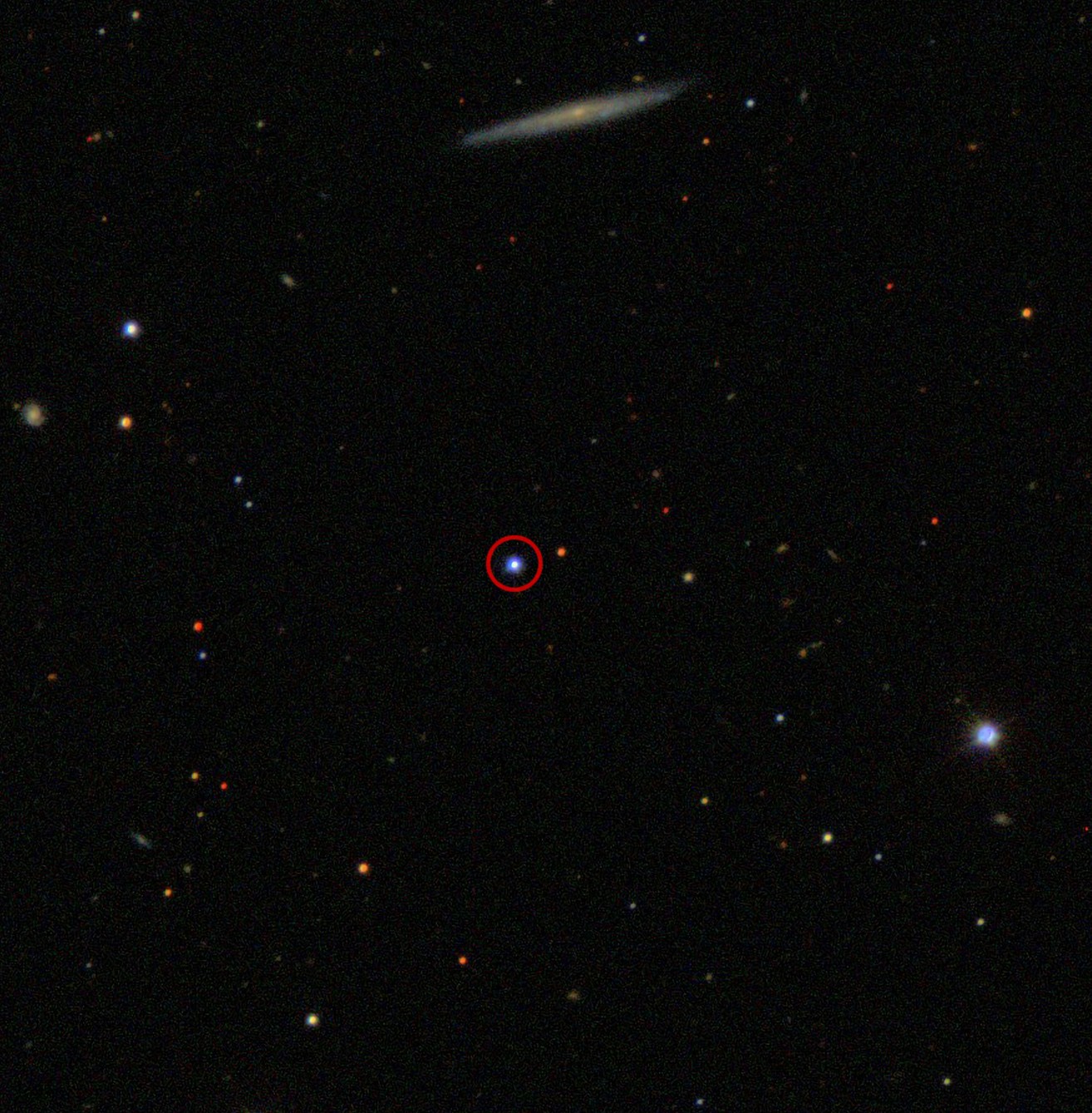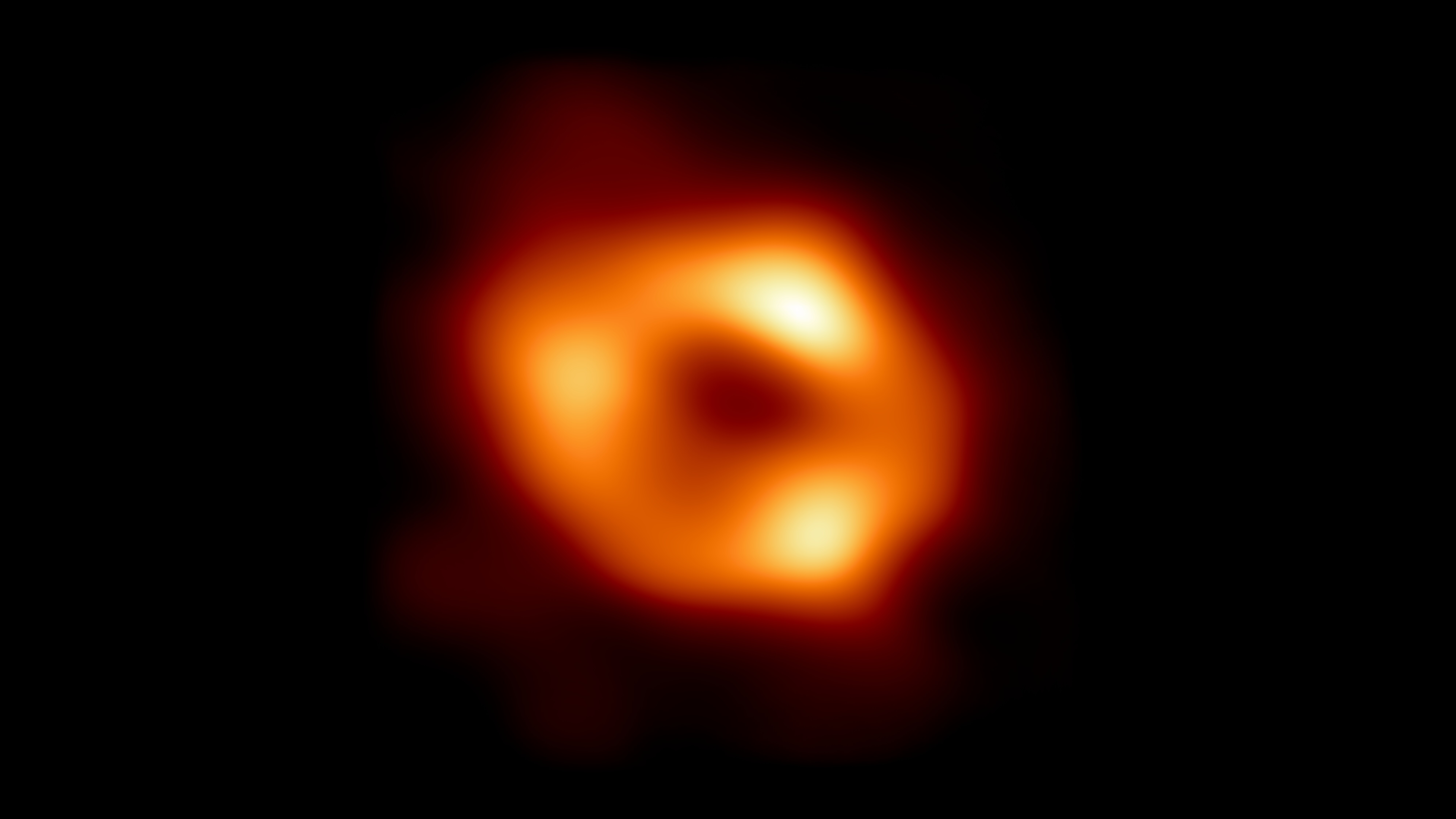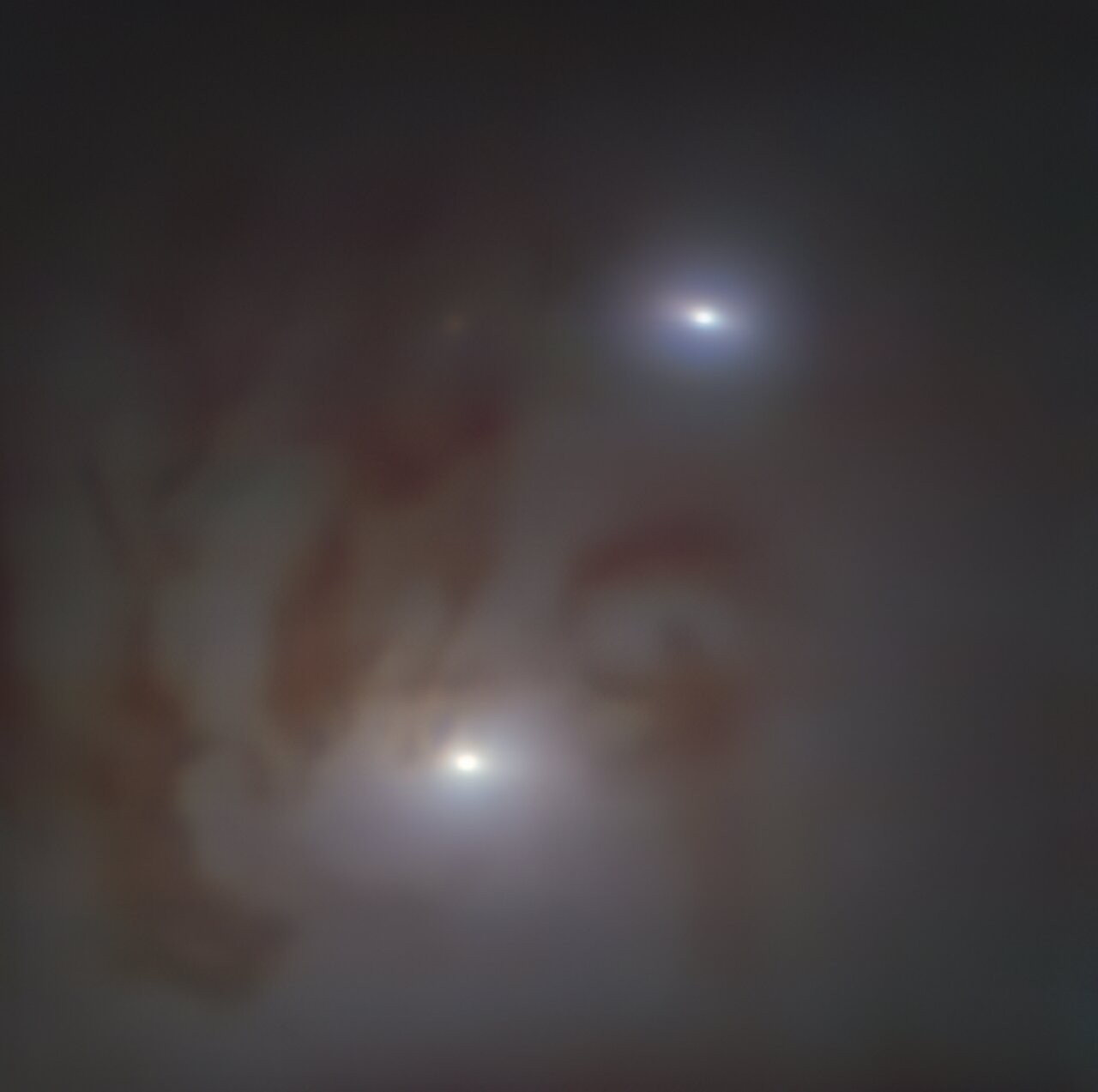Comparing the size of TON 618 to the Milky Way galaxy unveils a fascinating perspective on the scale of the universe. COMPARE.EDU.VN provides detailed comparisons to help you understand astronomical phenomena, and this article will explore the immense proportions of TON 618 relative to our galactic home. Discover the comparison and its astronomical significance.
1. Understanding TON 618: A Cosmic Behemoth
TON 618 is not just any black hole; it’s an ultramassive quasar containing one of the most massive black holes ever discovered. Located approximately 10.4 billion light-years away, this object challenges our understanding of cosmic scale. To appreciate its size, let’s delve into some of its key characteristics.
1.1. Defining Characteristics of TON 618
- Massive Black Hole: TON 618 houses a black hole with a mass estimated to be around 66 billion times that of the Sun.
- Quasar Activity: It is a quasar, which means it emits an enormous amount of energy across the electromagnetic spectrum due to the accretion of matter onto the black hole.
- Distance: Situated at a vast distance, the light we observe from TON 618 has traveled over 10 billion years to reach us, providing a glimpse into the early universe.
alt: TON 618 location circled in a visible light image from the Sloan Digital Sky Survey, indicating its vast distance
1.2. The Significance of its Discovery
The discovery of TON 618 has profound implications for astrophysics:
- Black Hole Formation: It challenges theories about how supermassive black holes form and grow in the early universe.
- Quasar Properties: Studying TON 618 helps scientists understand the extreme properties of quasars and their role in galactic evolution.
- Cosmological Distances: Its immense distance provides a unique opportunity to study the conditions of the universe billions of years ago.
2. The Milky Way: Our Galactic Home
In contrast to the distant behemoth TON 618, the Milky Way is our own galaxy, a spiral-shaped collection of stars, gas, dust, and a central supermassive black hole. Understanding the Milky Way’s characteristics helps put TON 618’s scale into perspective.
2.1. Key Features of the Milky Way
- Size and Structure: The Milky Way spans approximately 100,000 to 180,000 light-years in diameter. It is a barred spiral galaxy with several spiral arms.
- Central Black Hole: Sagittarius A* (Sgr A*), the supermassive black hole at the Milky Way’s center, has a mass of about 4.3 million times that of the Sun.
- Stellar Population: The galaxy contains hundreds of billions of stars, along with nebulae, star clusters, and various types of interstellar matter.
2.2. Importance to Our Understanding of the Universe
The Milky Way serves as a crucial reference point for astronomical studies:
- Galactic Dynamics: Studying the Milky Way helps us understand the dynamics of spiral galaxies and the processes that shape them.
- Stellar Evolution: It provides a laboratory for studying the life cycles of stars, from their birth in nebulae to their eventual demise as white dwarfs, neutron stars, or black holes.
- Cosmic Neighborhood: As our galactic home, it provides a local context for understanding the larger-scale structure of the universe.
alt: Image of Sagittarius A* taken by the Event Horizon Telescope, showing the ring of hot gas around the supermassive black hole
3. Direct Size Comparison: TON 618 vs. the Milky Way’s Black Hole
To grasp the scale of TON 618, a direct comparison with the Milky Way’s central black hole, Sagittarius A*, is essential. This comparison highlights the enormous difference in mass and size between these two cosmic entities.
3.1. Mass Comparison
| Feature | TON 618 | Sagittarius A* |
|---|---|---|
| Mass | 66 Billion Solar Masses | 4.3 Million Solar Masses |
| Mass Ratio | Approximately 15,349:1 | 1 |



This table illustrates that TON 618’s black hole is over 15,000 times more massive than Sagittarius A*.
3.2. Event Horizon Size Comparison
The event horizon is the boundary beyond which nothing, not even light, can escape a black hole’s gravitational pull. The size of the event horizon is directly proportional to the black hole’s mass.
- TON 618: With a mass of 66 billion solar masses, its event horizon is estimated to be about 390 billion kilometers in diameter. Light would take weeks to cross it.
- Sagittarius A*: With a mass of 4.3 million solar masses, its event horizon is approximately 25 million kilometers in diameter. Light would take only a few minutes to cross it.
alt: Composite image of NGC 7727 showing two bright knots, each representing a supermassive black hole surrounded by a dense star cluster
3.3. Visualizing the Scale Difference
To visualize this, imagine replacing Sagittarius A* with TON 618’s black hole. The event horizon of TON 618 would extend far beyond the orbit of Pluto in our solar system, dwarfing everything in its path.
4. How Does TON 618 Affect its Environment?
The sheer size of TON 618 has a significant impact on its surrounding environment. The immense gravitational pull and energy output from this quasar affect the structure and evolution of its host galaxy.
4.1. Gravitational Influence
- Orbital Dynamics: The gravitational field of TON 618 influences the orbits of stars and gas clouds within its host galaxy, causing them to move at extremely high speeds.
- Tidal Forces: The strong tidal forces near the black hole can disrupt and tear apart objects that venture too close, adding to the accretion disk.
4.2. Energy Output and Radiation
- Accretion Disk: The accretion disk surrounding TON 618 is incredibly hot due to the friction and compression of infalling matter, emitting intense radiation across the electromagnetic spectrum.
- Jets and Outflows: Quasars like TON 618 often launch powerful jets of particles and energy into intergalactic space, which can influence the formation of stars and galaxies in their path.
4.3. Impact on Galaxy Evolution
- Star Formation: The energy output from TON 618 can either stimulate or suppress star formation in its host galaxy, depending on the conditions and location.
- Galaxy Morphology: Over long timescales, the interactions between the quasar and its host galaxy can shape the galaxy’s morphology and overall structure.
5. Comparing TON 618 to Other Supermassive Black Holes
While TON 618 is exceptionally large, it’s useful to compare it to other supermassive black holes to understand its place in the cosmic hierarchy.
5.1. M87*
M87* is the supermassive black hole at the center of the Messier 87 galaxy, famous for being the first black hole to be directly imaged by the Event Horizon Telescope.
- Mass: Approximately 5.4 billion solar masses.
- Significance: Provided groundbreaking visual evidence of black holes.
5.2. OJ 287
OJ 287 is a blazar containing a supermassive black hole binary system.
- Primary Black Hole Mass: Estimated at 18 billion solar masses.
- Significance: Studying binary black holes helps understand merger events and gravitational waves.
5.3. Comparison Table
| Black Hole | Mass (Solar Masses) | Notable Features |
|---|---|---|
| TON 618 | 66 Billion | One of the most massive known black holes |
| M87* | 5.4 Billion | First black hole directly imaged |
| OJ 287 | 18 Billion | Binary black hole system |
| Sagittarius A* | 4.3 Million | Central black hole of the Milky Way |
6. Current Research and Future Studies
Scientists are continually studying TON 618 and other supermassive black holes to unravel their mysteries and understand their role in the universe.
6.1. Observational Techniques
- Radio Astronomy: Facilities like the Very Large Array (VLA) and the Atacama Large Millimeter/submillimeter Array (ALMA) are used to study the radio emissions from quasars and black holes.
- Optical and Infrared Telescopes: Telescopes like the Hubble Space Telescope and the James Webb Space Telescope observe the optical and infrared light from these objects.
- X-ray and Gamma-ray Observatories: Missions like Chandra and Fermi detect high-energy radiation from black holes, providing insights into their accretion processes.
6.2. Future Missions and Telescopes
- Laser Interferometer Space Antenna (LISA): A future space-based gravitational wave observatory that will detect low-frequency gravitational waves from merging supermassive black holes.
- Next Generation Very Large Array (ngVLA): An upgrade to the VLA that will provide unprecedented sensitivity and resolution for radio observations.
6.3. Key Research Questions
- Black Hole Formation: How do supermassive black holes like TON 618 form and grow to such enormous sizes in the early universe?
- Quasar Feedback: How does the energy output from quasars affect the evolution of their host galaxies and the surrounding intergalactic medium?
- Gravitational Waves: What can we learn about black hole mergers and the nature of gravity from the detection of gravitational waves?
7. Visual Analogy: Comprehending the Unfathomable
To truly comprehend the chasm between TON 618 and the Milky Way, visual analogies help make the unfathomable, fathomable.
7.1. The Solar System Analogy
If Sagittarius A* were the size of a marble, TON 618 would be the size of Mount Everest. This comparison places the mind on a relatable scale.
7.2. Population Analogy
If every person on Earth represented one solar mass, the Milky Way’s central black hole would be a city. TON 618 would be an entire continent filled with people.
7.3. Time Analogy
If the Milky Way took one year to consume an Earth-sized object, TON 618 would consume a similar object in a matter of seconds due to its immense gravitational pull.
8. Debunking Misconceptions About Black Holes
Common misconceptions often cloud public understanding of black holes. Let’s clarify some of the most prevalent myths.
8.1. Misconception 1: Black Holes Suck Everything In
- Reality: Black holes have gravity like any other object of the same mass. You would need to get relatively close to be pulled in.
8.2. Misconception 2: Black Holes Are Cosmic Vacuum Cleaners
- Reality: Black holes do not wander around sucking up everything in their path. They affect only what comes within their gravitational influence.
8.3. Misconception 3: Black Holes Are Invisible
- Reality: While the black hole itself is invisible, we can detect them by the light and radiation emitted from the accretion disk surrounding them or by observing their gravitational effects on nearby objects.
9. The Future of Galactic and Extragalactic Studies
With advancing technology, our understanding of galaxies and extragalactic phenomena will continue to evolve.
9.1. Advancements in Telescope Technology
Future telescopes will offer higher resolution and sensitivity, enabling us to study distant objects like TON 618 in greater detail.
9.2. Gravitational Wave Astronomy
The detection of gravitational waves opens a new window into the universe, allowing us to study black hole mergers and other cataclysmic events.
9.3. Theoretical Breakthroughs
Theoretical research will continue to refine our understanding of black hole formation, quasar activity, and the evolution of galaxies.
10. The Role of COMPARE.EDU.VN in Astronomical Understanding
COMPARE.EDU.VN serves as a vital tool for simplifying complex astronomical concepts and providing clear, concise comparisons.
10.1. Providing Comparative Analysis
COMPARE.EDU.VN excels in breaking down intricate scientific data into manageable comparisons, making it easier for the public to grasp the scale and significance of cosmic phenomena.
10.2. Enhancing Public Education
Through detailed articles and accessible explanations, COMPARE.EDU.VN enhances public understanding of astronomy and astrophysics, fostering a greater appreciation for the universe.
10.3. Facilitating Informed Decisions
By providing clear comparisons and debunking misconceptions, COMPARE.EDU.VN helps readers make informed decisions about their understanding of the cosmos.
Understanding the scale of TON 618 compared to the Milky Way provides a humbling perspective on our place in the universe. Through detailed comparisons and accessible explanations, we can begin to grasp the enormity of these cosmic entities and their profound impact on the cosmos.
Are you struggling to make sense of complex astronomical phenomena? Do you need clear, concise comparisons to aid your understanding? Visit COMPARE.EDU.VN today to explore detailed articles and insightful analyses that will help you grasp the scale and significance of the universe. Make informed decisions and enhance your knowledge with our expert comparisons. Contact us at 333 Comparison Plaza, Choice City, CA 90210, United States, or reach out via Whatsapp at +1 (626) 555-9090. Visit our website at compare.edu.vn.
Frequently Asked Questions (FAQ)
-
What exactly is TON 618?
TON 618 is an extremely distant and luminous quasar that hosts one of the most massive black holes ever discovered, estimated at 66 billion times the mass of the Sun. -
How far away is TON 618 from Earth?
TON 618 is approximately 10.4 billion light-years away from Earth. -
What is a quasar?
A quasar is an extremely luminous active galactic nucleus (AGN), powered by a supermassive black hole that accretes matter and emits vast amounts of energy. -
How does the mass of TON 618 compare to the black hole in the Milky Way?
The black hole in TON 618 is about 15,000 times more massive than Sagittarius A*, the supermassive black hole at the center of the Milky Way. -
What is the event horizon of a black hole?
The event horizon is the boundary around a black hole beyond which nothing, not even light, can escape its gravitational pull. -
How big is the event horizon of TON 618?
The event horizon of TON 618 is estimated to be about 390 billion kilometers in diameter. -
What tools do astronomers use to study TON 618?
Astronomers use various tools, including radio telescopes, optical telescopes, infrared telescopes, and X-ray observatories, to study TON 618 and other distant objects. -
How does TON 618 affect its surrounding environment?
TON 618’s immense gravity and energy output influence the orbits of stars and gas clouds in its host galaxy, stimulate or suppress star formation, and shape the galaxy’s overall structure. -
Are there any future missions planned to study objects like TON 618?
Yes, missions like the Laser Interferometer Space Antenna (LISA) and the Next Generation Very Large Array (ngVLA) are planned to study black hole mergers and distant objects in greater detail. -
Why is it important to study supermassive black holes like TON 618?
Studying supermassive black holes helps us understand black hole formation, quasar activity, galaxy evolution, and the conditions of the early universe.
